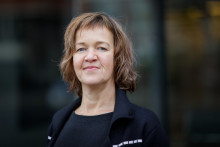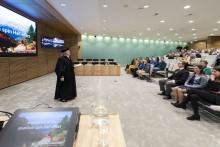‘Some people say that if you can’t describe your research to a five-year old, you’re a fraud.’ Csaba Daday, physicist at MESA+, strongly disagrees with this statement. ‘Some things are so precise and need such careful study that they are simply difficult to clarify.’
So the attempt to explain the unexplainable starts with a glow in the dark jellyfish. The first thing that would come to your writer’s layman’s mind is that it’s a Fukushima jellyfish. How different is reality, where the fish consists of photosensitive proteins that change by light.
Csaba: ‘These proteins have the ability to absorb and emit light, which produces a certain colour. This enables you to trace cells or processes in medicine or genetics. You can actually see what happens within cells.’
Light as the currency of energy
Csaba does not do any experiments himself. His priority is to describe computationally the microscopic processes when photosensitive proteins start to shine, in which colours and for how long. The Romanian researcher distinguishes ground states and electronically photo-excited states. ‘If a protein is low in energy, it can absorb light. This situation is called the ground state. But if it’s high in energy, it can emit light. This is when it lights up and is called the excited state.’
The antennas in these proteins are tuned to different colours of light to get to the excited state. They may also be turned on and off like microscopic light bulbs. Csaba: ‘I want to model the mechanisms underlying the response of these photo-biological systems.’
Csaba’s work is purely theoretical. Why is it necessary to capture these phenomena in calculations, when real-life experiments and applications are already taking place? ‘Scientists already work with these so-called photoactive biosystems. But they often explain their observations with the use of ad-hoc models which must be confirmed by more careful theoretical work. In fact, experimentalists can produce mutations a lot faster than we can keep up with.’ Csaba explains. ‘If we have a good model, we can predict more accurately what will happen and how to modify proteins to have more benefit from them.’
Chess is only black or white
When Csaba is not busy doing quantum mechanics, he likes to play bridge and chess. During his childhood, he even had a chess-coach. Although he never made a conscious link between the games and his research, there are indeed some similarities. ‘In chess, there is either right or wrong. There is no grey area. I see the resemblance in my work, where numbers are exact and results are indisputable.’
Also bridge could have a deeper meaning. ‘There are many hidden things in bridge. You have to make choices without knowing what cards your opponents have. I like to follow this philosophy in life. Sometimes you just need to make decisions without knowing everything.’







